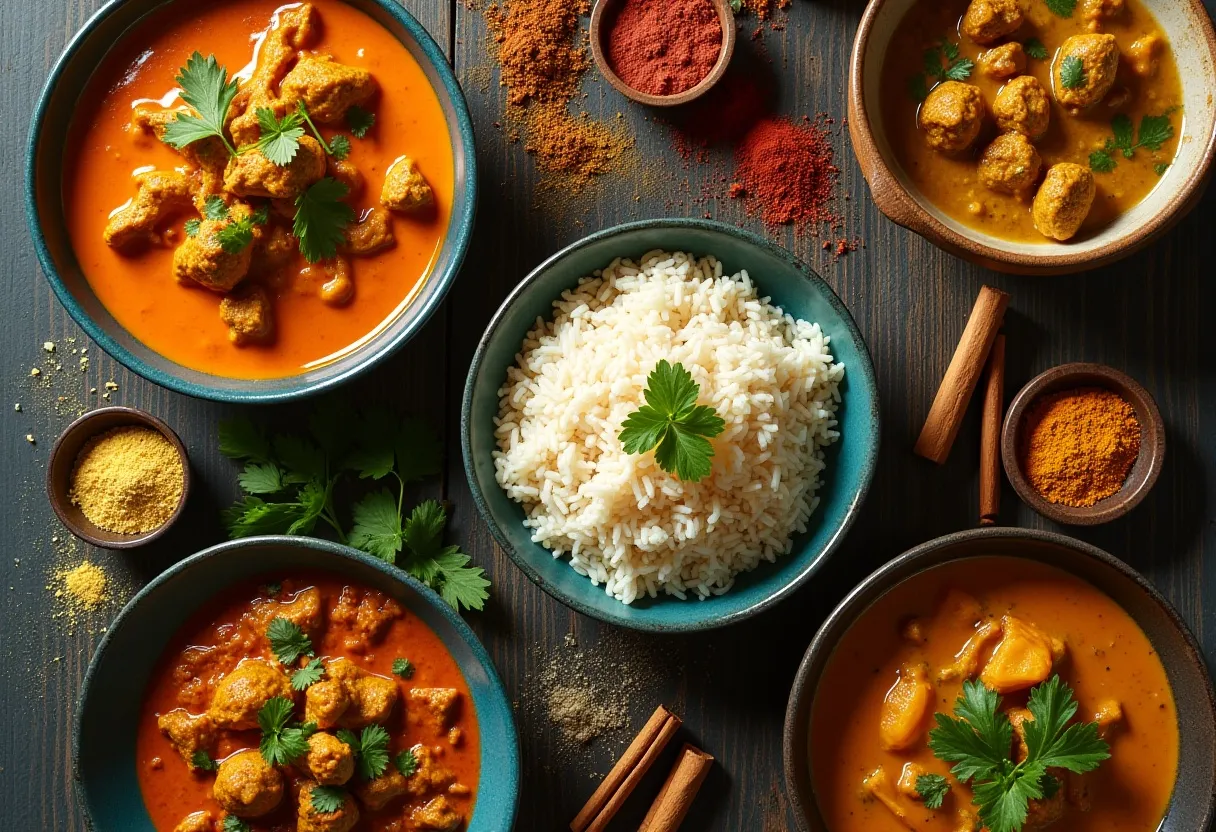
Curry is one of the most beloved — and misunderstood — foods in the world. Depending on where you are, it can mean a spice mix, a sauce, a hearty dish, or even an entire category of cuisine. From India and Japan to Thailand, the Caribbean, and Europe, curry has captured hearts (and taste buds) across the globe.
Picture saucy stews ladled over steaming basmati rice, aromatic spice blends ground fresh in a mortar, or a quick weeknight curry simmering on the stove — its forms are endless. But what exactly is curry, and what makes it so special?
With a complex history rooted in trade, migration, and cultural exchange, curry has traveled far beyond its Indian origins. It’s been adapted into Japanese comfort food, Caribbean stews, Thai coconut curries, and even European sauces. Today, curry is so universal that you’ll find it everywhere — from home kitchens to fine dining restaurants, and even pre-made on supermarket shelves.
Ready to unlock the magic of curry for your own cooking? In this guide, we’ll explore curry’s fascinating backstory, its many variations, and most importantly, the essential spices that make every version irresistible. Get ready to transform your kitchen into a world of flavor.
✨ Hungry for more? Explore dozens of delicious recipes, healthy eating hacks, and cooking inspiration over at BookOfFoods. From quick weeknight dinners to culinary deep-dives like this one, our blog is packed with ideas to make every meal unforgettable. Don’t just cook — create!
What Is Curry?
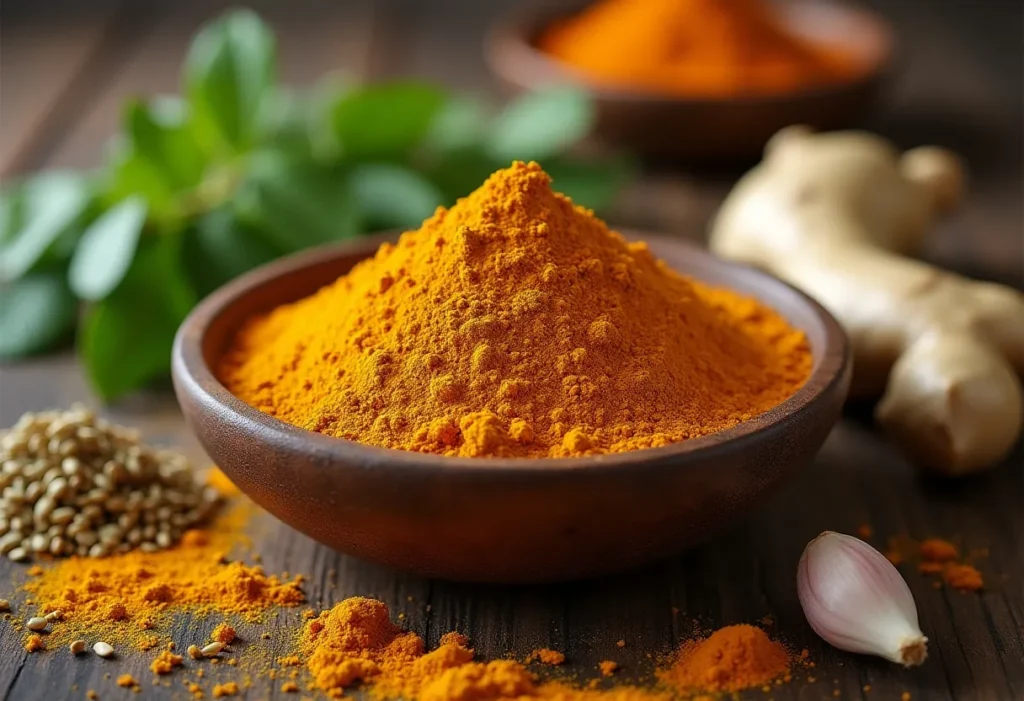
To understand curry, we need to go back to the basics. The word itself is often used as a catch-all term for a wide variety of dishes, but its roots are more specific. Originally, “curry” comes from the Tamil word kari, meaning sauce or relish for rice. In India, it has been linked to dishes like kadhi or to the use of curry leaves, a fragrant herb central to South Asian cooking.
As trade and travel expanded, however, the term “curry” evolved. Across the globe, it came to describe saucy, spice-rich stews typically served with rice, roti, or naan. Today, “curry” might mean a coconut-heavy Thai red curry, a comforting Japanese curry, or a creamy North Indian murgh makhani (butter chicken). While these dishes all have specific regional names, in North America and Europe they’re often grouped together simply as “curries.”
And then there’s curry powder — a British creation from the 18th century. Designed to mimic the complex masalas used in Indian kitchens, it blends turmeric, coriander, fenugreek, cumin, cinnamon, black pepper, ginger, and cardamom. While curry powder gained worldwide popularity for its convenience, it’s rarely used in India itself, where fresh, regional spice blends are the true heart of authentic curries.
Types of Curry by Region
From its roots in Asia, curry has traveled the globe, taking on countless variations along the way. While these dishes share common traits — rich sauces, aromatic spices, and comforting depth — each region has adapted curry to its own tastes, ingredients, and traditions.
Indian Curries
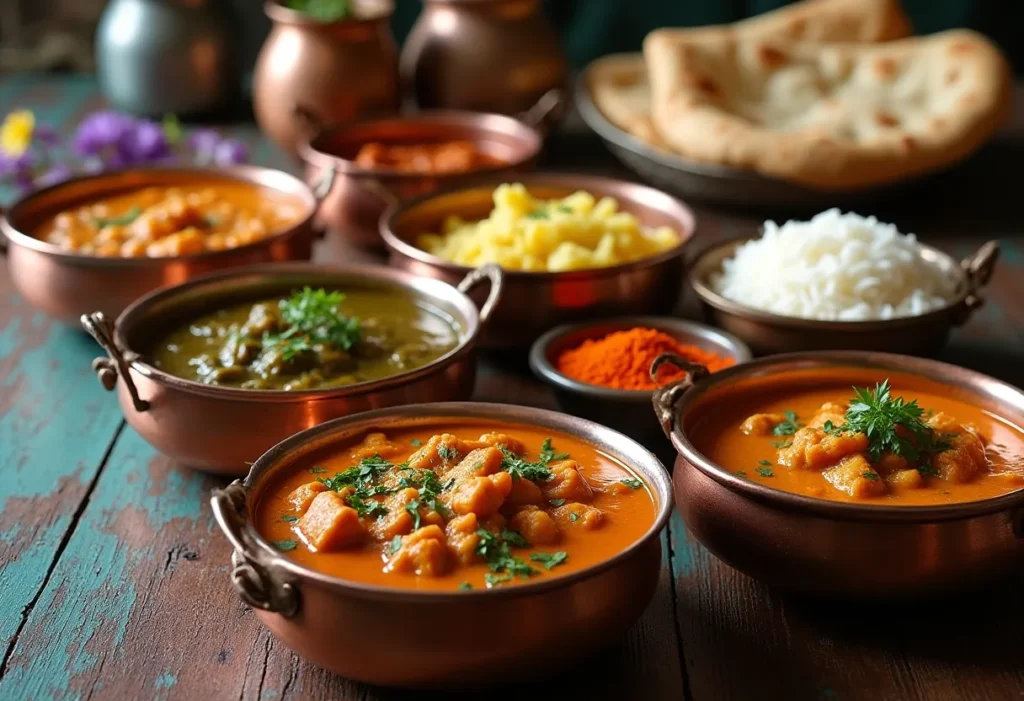
With a population of over 1.4 billion and dozens of distinct culinary traditions, it’s no surprise that India offers one of the most diverse curry repertoires in the world. Indian curries are celebrated for their bold spices, layered flavors, and remarkable variety. Many dishes aren’t traditionally referred to as “curries” within India, but internationally they’re widely recognized as such. Some of the most iconic examples include vindaloo, jalfrezi, palak paneer, korma, meen moilee, murgh makhani (butter chicken), and dal.
- Vindaloo – Originating in Goa during Portuguese colonization, vindaloo is a fiery, tangy dish made with Kashmiri chilies. Traditionally prepared with chicken, it can also be adapted with lamb or vegetables. Its deep red color and bold spice make it unforgettable.
- Jalfrezi – From Bengal, this stir-fried curry is thick, rich, and spicy. Built on a base of onions, tomatoes, and green chilies, it’s incredibly versatile — made with meat, fish, paneer, or vegetables.
- Palak Paneer – A vegetarian classic that pairs stewed spinach with fresh paneer cheese. Nutritious and flavorful, it’s often served with fluffy basmati rice or warm naan.
- Korma – A creamy, braised curry made by simmering meat or vegetables in stock and yogurt. Often enriched with cashews, tomatoes, and spices, korma can range from mild and nutty to rich and spicy.
Indian curries set the standard for how diverse and dynamic curry can be — and their influence is seen in kitchens all around the world.
Thai Curries
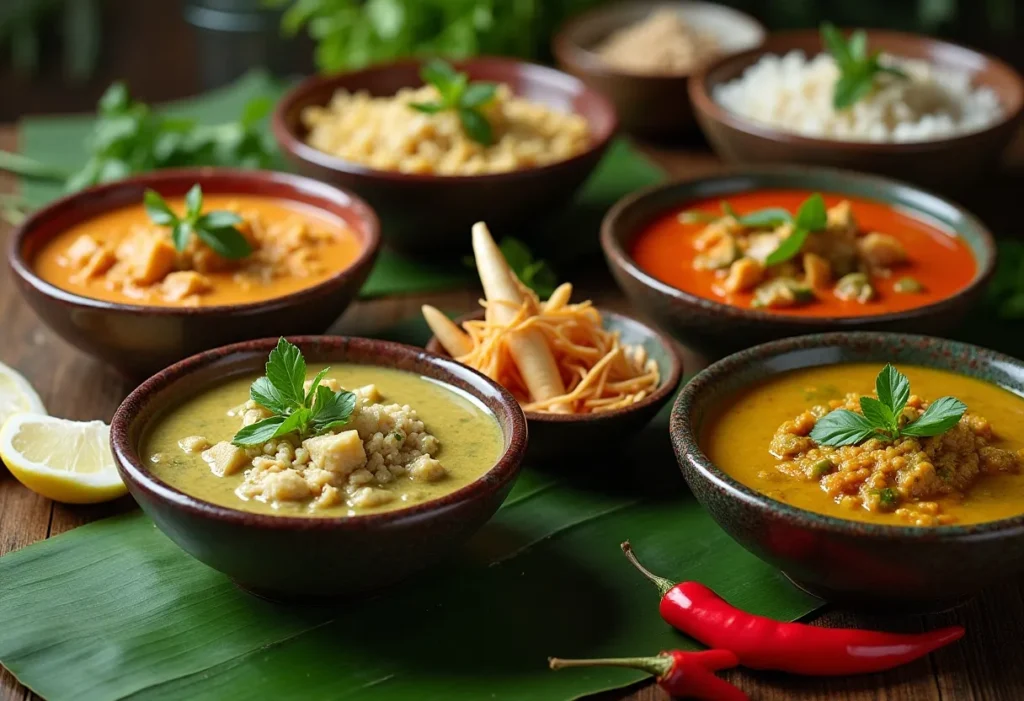
In Thailand, curry is as beloved as pad Thai, tom yum soup, or pad see new — and just as essential to the national culinary identity. While Thai curries share some similarities with Indian curries — they’re rich, saucy, and spice-driven — their flavor profiles are distinctly shaped by local ingredients like lemongrass, makrut lime, galangal, and coconut milk.
- Yellow Curry – Mild, creamy, and slightly sweet, yellow curry gets its signature golden hue from turmeric and curry powder. Balanced with coconut milk, coriander seeds, ginger, garlic, and lemongrass, it’s a comforting choice for those who prefer less heat.
- Red Curry – Made with red curry paste, this dish combines chili peppers with lemongrass, garlic, ginger, coriander, and fish sauce. Despite its fiery appearance, red curry usually falls into the medium-heat range, offering both spice and balance.
- Green Curry – Often considered the hottest Thai curry, green curry is also one of the most popular. Its vibrant color comes from fresh green chilies and herbs, while flavors of lemongrass, cumin, galangal, and fish sauce create a bold, complex taste.
- Panang Curry – Originating in the Panang region, this rich curry features a nutty, peanut-based sauce. Similar to red curry but creamier and more robust, it’s often served with chicken or shrimp.
- Massaman Curry – A milder curry with Persian and Indian influences, massaman stands out for its warm spices like cinnamon, cloves, and nutmeg. Traditionally made with chicken, it can also feature beef, goat, tofu, or vegetables for a hearty, aromatic dish.
Thai curries showcase a unique balance of heat, creaminess, and herbal freshness — making them some of the most versatile and widely loved curries worldwide.
Japanese Curries
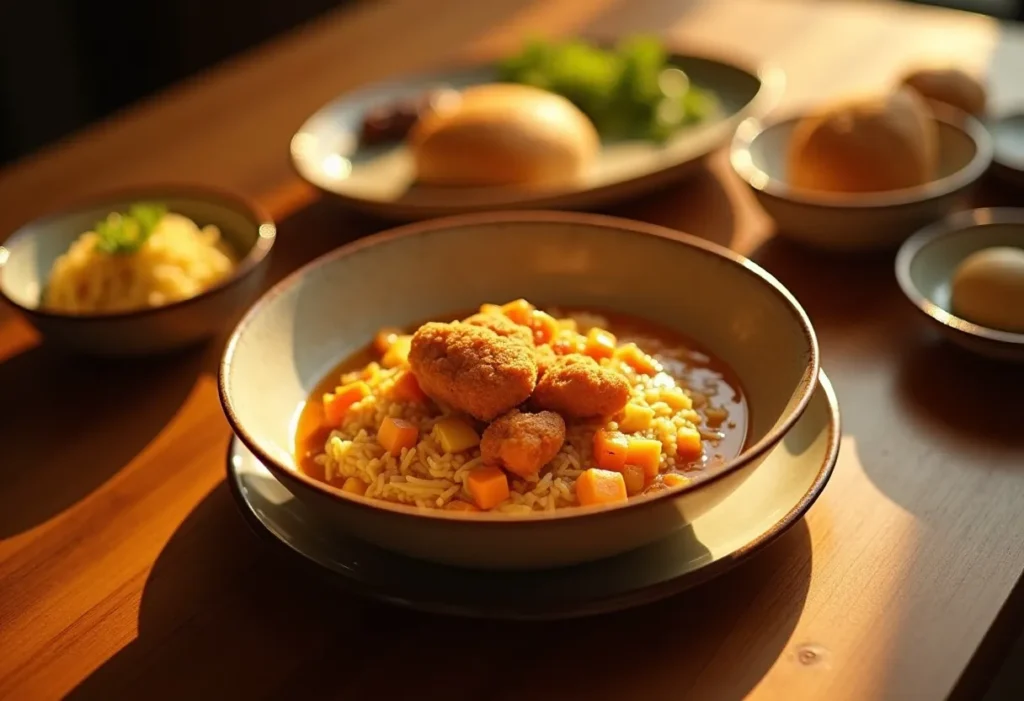
Curry made its way to Japan in the 19th century via the British Navy. Inspired by Indian flavors but adapted through British influence, Japanese curry developed into something entirely unique. Unlike its spicier cousins, Japanese curry is sweeter, milder, and characterized by its thick, gravy-like consistency. It’s hearty, comforting, and so beloved that it’s often considered a national dish.
- Kare Raisu (Curry Rice) – Perhaps the most iconic version, curry rice is a rich stew of meat, potatoes, and carrots ladled over short-grain Japanese rice. The sauce, thickened with a roux, is spiced with turmeric, cumin, fenugreek, and coriander, delivering warmth without overwhelming heat.
- Curry Udon – A Tokyo creation, this dish pairs thick wheat noodles with savory curry sauce. Its balance of comfort and mild spice makes it a favorite for cold days.
- Curry Bread (Kare Pan) – A portable snack, kare pan features Japanese curry encased in a soft, chewy bread roll coated in panko crumbs and fried until golden brown. Crispy outside, savory inside — it’s a staple in Japanese bakeries.
- Katsu Curry – A crowd-pleaser that combines crispy fried cutlets (pork, chicken, or beef) with curry rice. This filling, satisfying dish is so popular that entire chains specialize in serving katsu curry in endless variations.
Japanese curry blends heartiness with a mild sweetness, making it approachable and comforting — a true reflection of Japan’s talent for adapting global foods into distinctly local traditions.
Other Global Curries
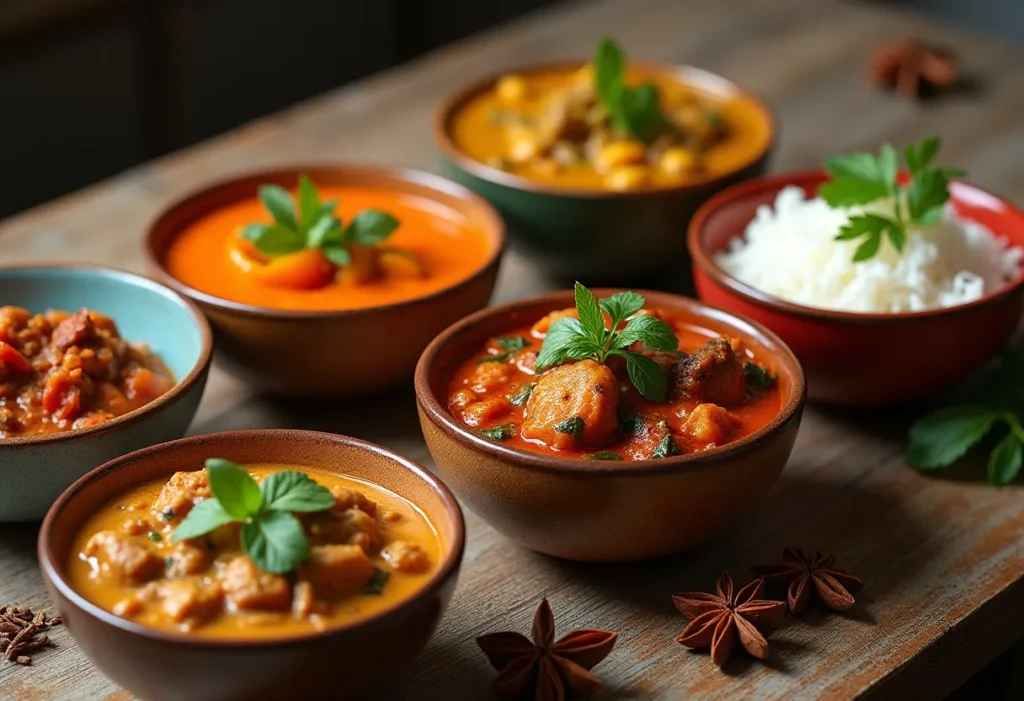
Curry’s journey across the globe has transformed it into a truly international dish. While the essence remains the same — a richly spiced sauce paired with meat, seafood, or vegetables and a hearty side like rice or bread — the flavors shift dramatically from region to region, reflecting local ingredients and culinary traditions.
- Great Britain – One of the most famous curries outside Asia, chicken tikka masala is said to have been created in the 1970s by a Bangladeshi chef in Glasgow. With marinated chicken charred over high heat and simmered in a creamy tomato sauce, it’s become so beloved that it’s often referred to as Britain’s “unofficial national dish.”
- Malaysia – Malaysian curries are a fusion of Thai, Indian, and Chinese influences, often featuring ingredients like star anise, clove, red chilies, and coriander. Favorites include beef rendang, a slow-cooked, aromatic dry curry, and laksa, a spicy noodle soup made with a coconut curry broth.
- South Africa – Durban curry, known for its deep red color and fiery heat, was first created by Indian laborers brought to work on sugarcane plantations. Made with tomatoes, curry leaves, vegetables, and a heavy dose of chili, it’s bold and uncompromising, especially since it avoids coconut milk or yogurt to temper the spice.
- Caribbean – In former British colonies, curry has become a staple of everyday cooking. Popular dishes like curry goat or curry crab blend Indian and British influences with Caribbean ingredients such as Scotch bonnet peppers, seafood, and coconut milk. Recipes are often adapted to suit local tastes, creating a vibrant patchwork of curry traditions.
From Europe to Africa to the islands of the Caribbean, curry proves its versatility time and again — evolving with each culture that embraces it, while still holding onto its flavorful heart.
Beginner’s Guide to Making Curry
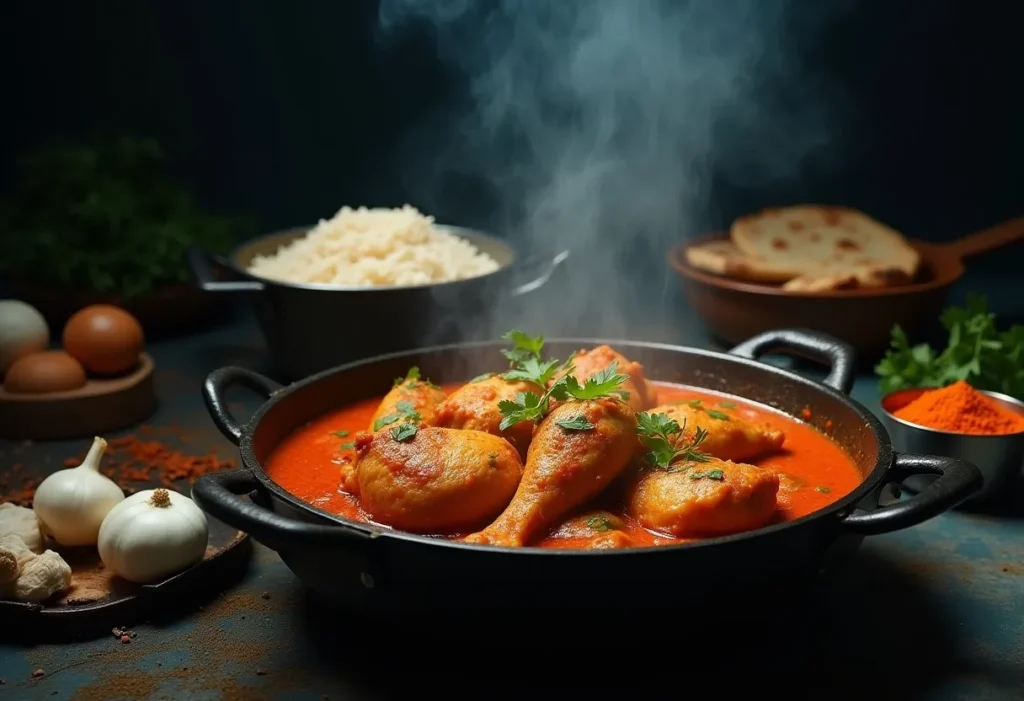
Now that you’ve explored curry’s fascinating journey around the world, it’s time to roll up your sleeves and bring those flavors into your own kitchen. If you’re just starting out, the best way to learn is by cooking a simple, approachable dish that still delivers layers of flavor.
Our Curry is the perfect beginner recipe: tender chicken breast simmered with tomatoes, fresh herbs, and aromatic spices. Ready in just 30 minutes, it tastes like it’s been slow-cooked all day. The key? Fresh, vibrant ingredients. (Pro tip: if your curry powder has been sitting in the back of your pantry for years, it’s time to replace it — spices lose their punch over time.)
Tips for Flavorful Success:
- Toast your spices. After browning the chicken, take a few extra minutes to sauté onions and garlic before adding the curry powder. Toasting the spices deepens their aromas and gives your dish a richer, more complex flavor.
- Pair with the right rice. Serve your curry over a bed of fragrant basmati rice. Its light, fluffy texture soaks up the sauce beautifully, turning every bite into comfort on a plate.
- Make extra. Double the recipe if you can — leftover curry is one of life’s great pleasures, and it only gets better as the flavors meld overnight.
Curry may seem intimidating, but with the right ingredients and a few easy steps, you’ll be amazed at how quickly you can master this global favorite.
Conclusion
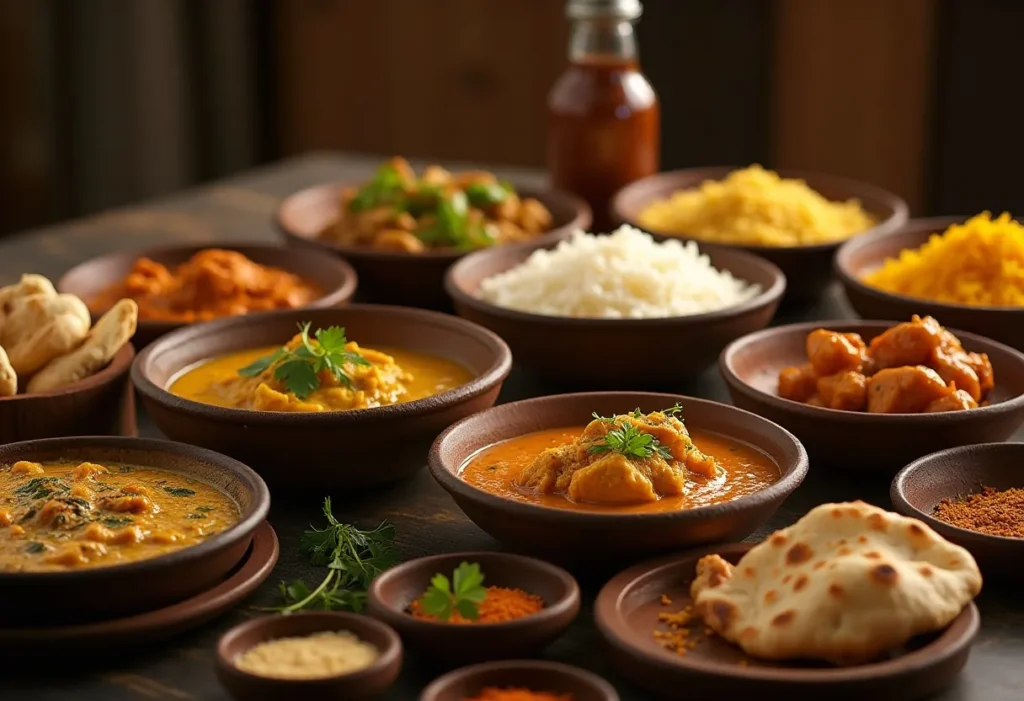
If you thought you knew curry before, now you’ve seen just how vast, complex, and fascinating its world truly is. What began as a regional tradition has become a global phenomenon — a word that embraces countless dishes, a rich history, and an endless variety of flavors. From spicy and bold to tangy and aromatic, curry is proof that food can unite cultures while still celebrating local identity.
The best part? You don’t have to travel the world to enjoy it. Your kitchen can be the gateway to this flavor-packed journey. Experiment with spices, try recipes from different regions, and adapt them to your own tastes and lifestyle. From fragrant soups and vibrant fish curries to weeknight chicken favorites and hearty vegetarian options, there’s a curry for every mood, occasion, and table.
When it comes to curry, the possibilities are endless — and every pot you simmer is another step into one of the world’s most delicious culinary traditions.

Share this Story
